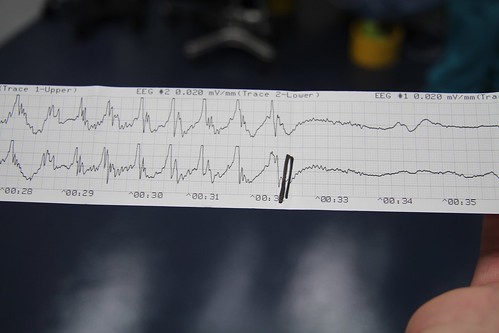Dr. Joshua Bess in the SeattleNTC treatment room. Dr. Bess is holding a the recorded brain waves from a patient.
When people hear Electroconvulsive Therapy or “shock therapy” the iconic scene of Jack Nicholson being strapped down and shocked in One Flew Over The Cuckoo’s Nest might come to mind. The scene is an exaggeration of course, but it also could not be further away from how ECT is really administered to patients today. And the surprising thing is that despite it’s reputation, ECT actually works for 80 percent of patients and is the most effective treatment for major depressive episodes. Now a clinic in Ballard is offering the procedure.
SeattleNTC, Seattle Neuropsychiatric Treatment Center, opened their center at Swedish Ballard campus earlier this month and offers ECT to their patients. Dr. Joshua Bess, M.D. showed the Ballard News-Tribune around their clinic in between patients. The treatment room is clean and well lit and much like an operating room. The ECT machine rests above a table. It looks almost like an old radio attached to metal paddles. Dr. Bess said that their machine is from the late 90s and that ECT machines haven’t changed much since the 80s as far as the mechanical function.
Treatments take around thirty minutes and the actual use of the ECT machine is thirty seconds, the other time is spent anesthetizing patients and for recovery or reorientation time when the patient is revived from the procedure.
“ECT involves passing electrical pulses through a person’s brain to produce intense brain activity during a brief period of time. … Patients are completely under for the procedure, so most of the time spent in the center is recovering,” said Dr. Bess.
So what’s really happening? The ECT machine delivers a 30 to 100-joule electrical current in intervals for about six to eight seconds through two paddles. Dr. Bess compared it to an “electric drip.” The administrator is looking for the seizure threshold of the patient, or the point when the patient falls into a seizure. The seizure “resets” the electrical composition of the brain and usually in a manner that is beneficial to patients’ mental health (80 percent). ECT treatment involves multiple administrations given two or three times per week until the symptoms cease.
According to Dr. Bess, SeattleNTC administered 3,000 ECT treatments in 2015 and currently administers 18 to 20 treatments per day.

The paper tape shows the point at which the patient slipped into a seizure around the 30 second marker. This is known as the seizure threshold.
In the treatment room, Dr. Bess unfolded a long paper tape that recorded the brain waves of a patient during the last procedure. Erratic lines show the brain activity over the course of the whole treatment. At about the 30-second marker, the jumping line goes flat. The strip is showing a seizure – when it starts and ends.
According to SeattleNTC remission rates are 60 to 90 percent for people who have not responded to talk therapy or medication. However, there are some side effects to the treatment and could include confusion and memory loss. However, Dr. Bess said that it’s rare to for patients to forget major things like teachers, life events or spouses.
The treatment has been around since the 40s and according to Dr. Bess the actual instruments haven’t changed much, it’s really the administration of of the treatment. When the treatment was first introduced anesthesia wasn't used and patients would suffer muscle spasms during the seizures that resulted in spinal fractures and other problems. By fully putting patients under and the use of muscle relaxers, the fractures were eliminated and the use of the treatment has grown. However, films like One Flew Over The Cuckoo’s Nest haven’t done much to paint the treatment in a positive light.
“It really isn’t like how it’s showed in the movies. Not at all.”
In fact Dr. Bess has been administering the treatment for the last 10 years and said that when coupled with medications, it is a good option for people with chronic depression.
“It means everything when a patient says ‘Thanks for my life back.’ The fact is that it works.”
However, the treatment is reserved for after other less invasive treatments are tried, such as talk therapy and medication. Dr. Bess reported that one-third of depressed patients do not get well even after trying four medications or medication combinations. Also, after two to three failed medication trials, depressed patients only have a 17 percent chance of responding to additional medication trials. A response to ECT by those same patients is 60 to 80 percent.
“We typically see positive clinical response and substantial reduction in suicidal thoughts among our patients within one to three weeks.”
SeattleNTC has offices in Seattle, Redmond and Issaquah. For more information visit www.seattlentc.com